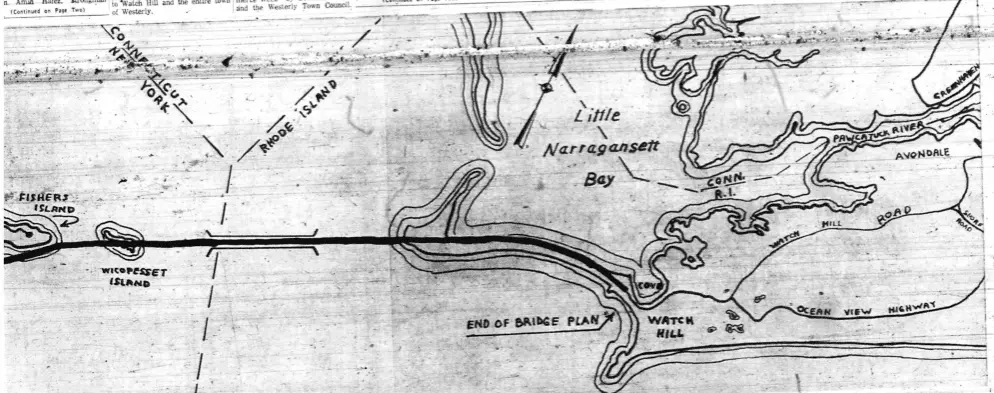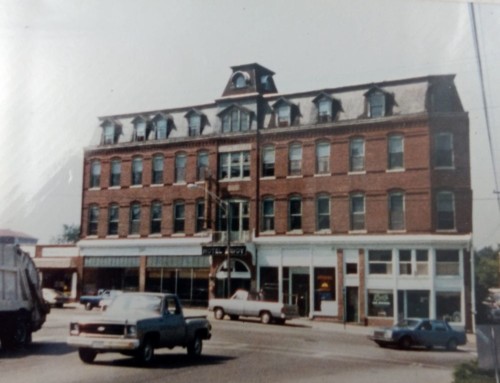Anyone who has driven down the east coast of the United States will tell you, if there was a way to avoid traffic in New York City, they would take it in a heartbeat. Several times over the last 80 years, this nearly became a reality, and in the process, Westerly almost became the end point of what would have been the second longest over-water bridge in the world at the time. [1]
Despite being just six miles further than Block Island, the shortest route to eastern Long Island from Westerly by car is 224 miles. Due in large part to the lack of direct route as well as the need to alleviate the traffic through New York City, a bridge connecting eastern Long Island to New England was proposed multiple times. The first such proposal came in 1938 from the desk of Senator Royal Copeland of New York, who was also the Chairman of the State Commerce Committee.[2]
Copeland went as far as ordering engineering surveys to determine the viability of a bridge crossing Long Island Sound and terminating in either Groton, Connecticut or Watch Hill.[3] Unfortunately, Copeland died on June 17, 1938, and with that, his idea was shelved. It has also been suggested that the United States’ entry into World War II in late 1941 contributed to the lack of interest in the bridge for many years after Copeland’s death.[4]
It was not until nearly 20 years later that a bridge from Long Island to Rhode Island was pitched once again, in the wake of post-war prosperity and the rise of suburbanization, which led to the development of the land on Long Island. In 1957, Charles H. Sells, former New York State Department of Public Works Superintendent and Port Authority commissioner proposed a two bridge plan with one of the bridges extending between Orient Point, New York and Watch Hill.[5]
In response to this proposal, a group of Long Island land developers met with the Westerly-Pawcatuck Chamber of Commerce. This group indicated that they intended to develop the eastern end of Long Island and sought to give residents an exit route which did not involve travel through the city.[6] The meeting was held in Watch Hill overlooking the proposed approach area on Napatree Point. The Chamber’s stance on the bridge at that time was one of firm opposition, a stance they held through every subsequent proposal.[7] The 1957 plan, however, was canceled by New York Governor W. Averell Harriman, due to its high cost and low traffic predictions.[8]
In 1963, in spite of the inauspicious ends to the previous plans for a bridge crossing Long Island Sound, the most ambitious and promising plan was put forth and made the span appear as a very real possibility. By July 1963, planning truly began when a financial and engineering study was published by famed construction engineer E. Lionel Pavlo.[9] That same month, the Tri-State Bridge Committee held a meeting at the Mohican Hotel in New London, Connecticut.[10]
In October of that year, the Westerly Sun obtained a copy of Pavlo’s study and subsequently published many details about a proposed bridge extending from Orient Point to Watch Hill.[11] According to the Sun’s report on the study, the proposed bridge would terminate on Fort Road in Watch Hill, approaching Napatree Point from the southeast from Fisher’s Island via Wicopesset Island.[12]
It was also noted that the bridge was likely to be four lanes wide to accommodate the anticipated traffic. As a result, any state roadway leading to the bridge would also need to be four lanes wide and would require new roadways connecting to Route 1, which it was hoped the State of Rhode Island would fund.[13] The most oft-quoted price tag for the bridge was $250 million ($2.04 billion in 2019) which would be financed by 40-year bonds.[14]
Because the bridge would be a toll bridge, it could not be subsidized by the federal government.[15] According to the New York Times, at a total length of 23.4 miles, the proposed bridge would be “the second longest bridge of its kind in the United States,” only 0.4 miles shorter than the Lake Pontchartrain Causeway in Louisiana.[16] While the Pavlo study was encouraging to those who supported the idea of a bridge to Watch Hill, it was noted that construction would take six years.[17]
[su_accordion class=””] [su_spoiler title=”Footnotes” open=”no” style=”default” icon=”plus” anchor=”” class=””]
- “Tri-State Agency to Study Proposed Long Island Span” Westerly Sun, 16 August 1963.
- New York Department of Transportation, “Long Island Sound Crossing Feasibility Study” December 2017, pg. 7.
- New York Department of Transportation, “Long Island Sound Crossing Feasibility Study” December 2017, pg. 7.
- New York Department of Transportation, “Long Island Sound Crossing Feasibility Study” December 2017, pg. 7.
- New York Department of Transportation, “Long Island Sound Crossing Feasibility Study” December 2017, pg. 7.
- Utter, Charles W., “Orient Point to Rhode Island Bridge Creating Local Concern” Westerly Sun, 13 November 1963.
- Utter, Charles W., “Orient Point to Rhode Island Bridge Creating Local Concern” Westerly Sun, 13 November 1963.
- New York Department of Transportation, “Long Island Sound Crossing Feasibility Study” December 2017, pg. 7.
- Utter, Charles W., “Orient Point to Rhode Island Bridge Creating Local Concern” Westerly Sun, 13 November 1963.
- “Tri-State Agency to Study Proposed Long Island Span” Westerly Sun, 16 August 1963.
- Utter, Charles W., “Orient Point to Rhode Island Bridge Creating Local Concern” Westerly Sun, 13 November 1963.
- “Bridge Project Ends Here” Westerly Sun, 9 October 1963.
- “Bridge Project Ends Here” Westerly Sun, 9 October 1963.
- “Bridge Project Ends Here” Westerly Sun, 9 October 1963.
- Utter, Charles W., “Orient Point to Rhode Island Bridge Creating Local Concern” Westerly Sun, 13 November 1963.
- “L. I. BRIDGE STUDY STARTED AFRESH; Earlier Plans for 23.4‐Mile Span Across the Sound Are Called ‘Superficial’; A WIDER REPORT SOUGHT; Committee Governor Named Holds First Meeting on Long‐Sought Project” New York Times, 23 May 1964.
- “Tri-State Agency to Study Proposed Long Island Span” Westerly Sun, 16 August 1963.
[/su_spoiler] [/su_accordion]






